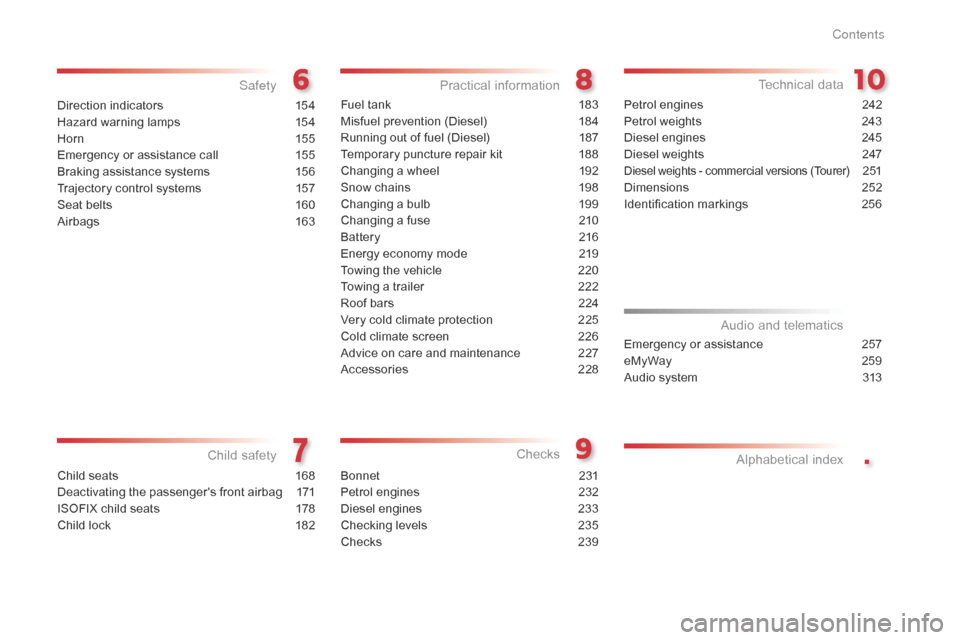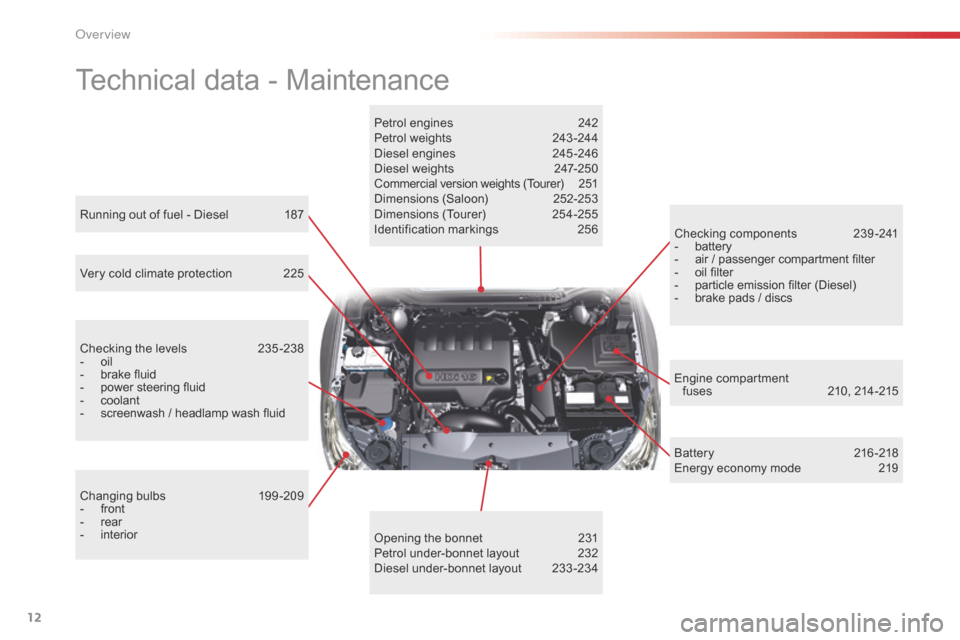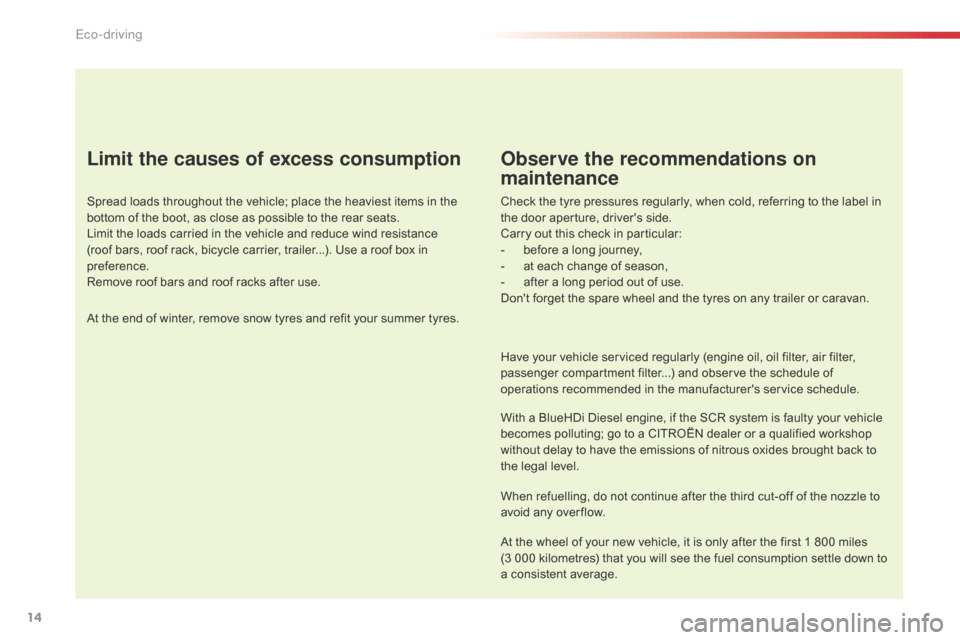maintenance Citroen C5 RHD 2015 (RD/TD) / 2.G Owner's Manual
[x] Cancel search | Manufacturer: CITROEN, Model Year: 2015, Model line: C5 RHD, Model: Citroen C5 RHD 2015 (RD/TD) / 2.GPages: 344, PDF Size: 12.96 MB
Page 5 of 344

.
Direction indicators 154
Hazard warning lamps
1
54
Hor n
15
5
Emergency or assistance call
1
55
Braking assistance systems
1
56
Trajectory control systems
1
57
Seat belts
1
60
Airbags
1
63Fuel tank
1 83
Misfuel prevention (Diesel) 1 84
Running out of fuel (Diesel)
1
87
Temporary puncture repair kit
1
88
Changing a wheel
1
92
Snow chains
1
98
Changing a bulb
1
99
Changing a fuse
2
10
Battery
2
16
Energy economy mode
2
19
Towing the vehicle
2
20
Towing a trailer
2
22
Roof bars
2
24
Very cold climate protection
2
25
Cold climate screen
2
26
Advice on care and maintenance
2
27
Accessories
2
28
Bonnet
23
1
Petrol engines
2
32
Diesel engines
2
33
Checking levels
2
35
Checks
23
9Petrol engines
2 42
Petrol weights 2 43
Diesel engines
2
45
Diesel weights
2
47
Diesel weights - commercial versions (Tourer) 2 51
Dimensions
2
52
Identification markings
2
56
Emergency or assistance
2
57
eMyWay
2
59
Audio system
3
13
Audio and telematics Alphabetical index
Child safety Practical information
Checks
Safety
Technical data
Child seats 1
68
Deactivating the passenger's front airbag
1
71
ISOFIX child seats
1
78
Child lock
1
82
Contents
Page 14 of 344

12
Technical data - Maintenance
Petrol engines 242
Petrol weights 2 43 -244
Diesel engines
2
45 -246
Diesel weights
2
47-250
C ommercial version weights (Tourer)
2
51
Dimensions (Saloon)
2
52-253
Dimensions (Tourer)
2
54-255
Identification markings
2
56
Opening the bonnet
2
31
Petrol under-bonnet layout
2
32
Diesel under-bonnet layout
2
33 -234
Running out of fuel - Diesel
1
87
Checking the levels
2
35 -238
-
oil
-
brake fluid
-
power steering fluid
-
coolant
-
screenwash / headlamp wash fluid
V
ery cold climate protection
2
25
Changing bulbs
1
99-209
-
front
-
rear
-
interior C
hecking components
23
9-241
-
battery
-
air / passenger compartment filter
-
oil filter
-
particle emission filter (Diesel)
-
brake pads / discs
B
atter y
21
6 -218
Energy economy mode
2
19
Engine compartment
fuses
21
0, 214 -215
over view
Page 16 of 344

14
Limit the causes of excess consumption
Spread loads throughout the vehicle; place the heaviest items in the
bottom of the boot, as close as possible to the rear seats.
Limit the loads carried in the vehicle and reduce wind resistance
(roof bars, roof rack, bicycle carrier, trailer...). Use a roof box in
preference.
Remove roof bars and roof racks after use.
At the end of winter, remove snow tyres and refit your summer tyres.
Observe the recommendations on
maintenance
Check the tyre pressures regularly, when cold, referring to the label in
the door aperture, driver's side.
Carry out this check in particular:
-
b
efore a long journey,
-
a
t each change of season,
-
a
fter a long period out of use.
Don't forget the spare wheel and the tyres on any trailer or caravan.
Have your vehicle serviced regularly (engine oil, oil filter, air filter,
passenger compartment filter...) and observe the schedule of
operations recommended in the manufacturer's service schedule.
With a BlueHDi Diesel engine, if the SCR system is faulty your vehicle
becomes polluting; go to a CITROËN dealer or a qualified workshop
without delay to have the emissions of nitrous oxides brought back to
the legal level.
When refuelling, do not continue after the third cut-off of the nozzle to
avoid any over flow.
At the wheel of your new vehicle, it is only after the first 1 800 miles
(3 000 kilometres) that you will see the fuel consumption settle down to
a consistent average.
Eco-driving
Page 70 of 344

68
We recommend use of the automatic regulation
of the air conditioning.
It permits automatic and optimised control
of all of the following functions: air flow,
temperature in the passenger compartment
and air distribution, by means of various
sensors (ambient temperature, sunshine).
This eliminates any need for you to change
your settings other than the temperature value
displayed.
F Take care not to cover the sunshine sensor A .
If you select the automatic mode
(by pressing the "AUTO" control) and leave
all of the vents open, optimum comfort will be
maintained and humidity and condensation will
be removed regardless of the exterior climatic
conditions.
The temperature in the passenger compartment
can only be lower than the ambient temperature
if the air conditioning is on.
In order to be effective, the air conditioning must
be used with the windows closed. If the vehicle
has been parked in the sun for a long period and
the interior temperature is very high, first ventilate
the passenger compartment with the windows
open for a few minutes, then close the windows.
Heating, ventilation and air conditioning recommendations
To keep the air conditioning system in
good working order it is essential that it is
operated at least once a month.
The air conditioning uses engine power
during its operation. As a result, the fuel
consumption of the vehicle increases.
In certain cases of particularly arduous use
(e.g. towing the maximum load on a steep
gradient in high temperatures), switching off
the air conditioning saves engine power and
improves the towing capacity.
Air inlet
Check that the exterior grille for the air inlet,
at the bottom of the windscreen, is clean and
free of dead leaves, snow, etc.
When washing the vehicle using a high
pressure nozzle, avoid spraying at the air
inlet. Maximum comfort is obtained by means of
a good distribution of air in the passenger
compartment, both in the front and in the rear.
To obtain a uniform distribution of air, take
care not to block the exterior air intake grille
located at the base of the windscreen, the
vents, the air outlets under the front seats and
the air extractor located behind the flaps in
the boot.
The front and rear vents are fitted with
thumbwheels to adjust the air flow and
direction. We recommend that you leave all of
the vents open.
Dust filter / Odour filter
(active carbon)
There is a filter for excluding odours and
dust.
This filter must be changed in line with the
vehicle's servicing schedule. (Refer to the
maintenance and warranty guide).
Air conditioning
Air circulation
Ease of use and comfort
Page 125 of 344

123
Reactivation
In the event of a fault with the system,
the "ECO OFF" switch warning lamp flashes
then comes on continuously.
Have it checked by a CITROËN dealer or a
qualified workshop.
In the event of a fault in STOP mode, the
vehicle may stall: all the instrument panel
warning lamps come on. It is then necessary
to switch off the ignition and start the engine
again using the key.
Operating fault Maintenance
This system requires a 12 V battery with a
special specification and technology (reference
numbers available from CITROËN dealers).
Fitting a battery not listed by CITROËN
introduces the risk of malfunction of the
system.
To charge the battery, use a 12 V charger and
observe the polarity.Before doing anything under the
bonnet, deactivate the Stop & Start
system to avoid any risk of injury
resulting from automatic operation of
START mode.
The Stop & Start system makes use of
advanced technology. For any work on
the system go to a qualified workshop
with the skills and equipment required,
which a CITROËN dealer is able to
provide.
The system is reactivated automatically
at every new start using the key.
Press the "ECO OFF" switch again.
The system is active again; this is confirmed
by the switch warning lamp going off and a
message in the screen.
4
Driving
Page 201 of 344

199
Changing a bulb
Front lamps
Model with Xenon headlamps (D1S)
1. Dual-function Xenon headlamps (dipped/main): D1S
2.
C
ornering lighting: HP19
3.
Daytime running lamps / sidelamps (LEDs)
For the maintenance of the front lamps and
changing HP19 and D1S bulbs and LED lamps,
contact a CITROËN dealer or a qualified
workshop.
Risk of electrocution
Xenon bulbs must be replaced by
a CITROËN dealer or a qualified
workshop.
You are advised to change both D1S
bulbs at the same time, if one of them
has failed.
The headlamps are fitted with
polycarbonate glass with a protective
coating:
F
d
o not clean them using a dr y
or abrasive cloth, nor with a
detergent or solvent product,
F
u
se a sponge and soapy water or
a
pH neutral product,
F
w
hen using a high pressure washer
on persistent marks, do not keep
the lance directed towards the
lamps or their edges for too long,
so as not to damage their protective
coating and seals. Changing a bulb should only be done
after the headlamp has been switched
off for several minutes (risk of serious
burns).
F
D
o not touch the bulb directly with
your fingers, use a lint-free cloth.
It is imperative to use only anti-
ultraviolet (UV) type bulbs to avoid
damaging the headlamp.
Always replace a failed bulb with a
new bulb with the same type and
specification.
8
Practical information
Page 202 of 344

200
Dipped beam headlamps
F Remove the protective cap B.
F D isconnect the connector by pressing it
between the thumb and index finger.
F
F
ree the bulb from its two metal clamps.
F
T
ake out the bulb.
F
R
eplace the bulb, exerting a slight axial
force.
F
R
efit the connector, until it is all the way in.
F
R
efit the protective cap B .
Main beam headlamps
F Remove the protective cap A .
F D isengage the retaining spring.
F
R
emove the bulb and replace it, paying
attention to the direction of fitting.
F
R
efit the retaining spring.
F
R
efit the protective cap A .
Model with halogen headlamps
1. Main beams: H1
2. D ipped beams: H7
3.
D
irectional lighting: H7
4.
D
aytime running lamps / sidelamps (LEDs)
For the maintenance of the front lamps and
changing LED lamps, contact a CITROËN
dealer or a qualified workshop.
Practical information
Page 229 of 344

227
Matt paint
If you vehicle is finished with a clear matt
lacquer, please observe the following
recommendations to avoid damaging the
paintwork by the use of an inappropriate
cleaning procedures.
These recommendations are also valid for alloy
road wheels finished with clear matt lacquer.From the range of cleaning and maintenance products in the "TECHNATURE" range recommended
and approved by CITROËN, use only the insect remover and car shampoo, which are the only
products to be used on the bodywork.
The insect remover can also be used to remove minor marks (for example: finger marks...).
Always have paint repairs done by a CITROËN dealer or a qualified workshop.Never clean the vehicle without water.
Never wash your vehicle in an automatic roller brush car wash.
Never polish the vehicle body, nor the alloy wheels. Doing this will make the paintwork
shiny.
Do not use paint cleaners, abrasive products or paint polishing or preserving products (such
as wax, for example) on the paintwork. These products are only suitable for bright finishes.
Application of these products on vehicles with a matt finish will seriously damage the paint
sur face of the vehicle, giving rise to irreversible shiny or stained areas.
Never use a high pressure jet wash with a lance fitted with a brush, this may scratch the
paintwork.
Never select a wash programme that finishes with a hot wax cycle.
We recommend the use of a high pressure jet wash, or at least a water hose with a high
output.
We recommend that the vehicle be rinsed using de-ionised water.
Use only a microfibre cloth to dry the vehicle. It must be clean and used without heavy
pressure.
Lightly wipe off any fuel stains present on the bodywork using a soft cloth, then leave to dry.
Advice on care and maintenance
Recommendations on the care and maintenance your vehicle are given in the maintenance and warranty guide.
8
Practical information
Page 236 of 344

234
HDi 160 - HDi 200 engines
1. Screenwash and headlamp wash reservoir.
2.
P
ower steering and suspension fluid
reservoir.
3.
E
ngine coolant header tank.
4.
E
ngine oil dipstick.
5.
E
ngine oil filler cap.
6.
A
ir filter.
7.
B
rake fluid reservoir.
8.
B
attery. HDi 160
HDi 200
The Diesel fuel system operates under
high pressure:
-
N
ever carry out any work yourself
on this system.
-
H
Di engines make use of advanced
technology.
All maintenance and repairs require
special qualifications which only a
CITROËN dealer can guarantee.
Checks
Page 241 of 344

239
Checks
12 V battery
The battery does not require any maintenance.
However, check that the terminals are clean
and correctly tightened, particularly in summer
and winter.
The presence of this label, in particular with
the Stop & Start system, indicates the use of
a specific 12 V lead-acid battery with special
technology and specification. The involvement
of a CITROËN dealer or a qualified workshop
is essential when replacing or disconnecting
the battery. Unless other wise indicated, check these components in accordance with the manufacturer's service schedule and according to your engine.
Other wise, have them checked by a CITROËN dealer or a qualified workshop.
Air filter and passenger compartment filter
Depending on the environment (e.g. dusty
atmosphere) and the use of the vehicle (e.g.
city driving), replace them twice as often if
necessary.
A clogged passenger compartment filter may
have an adverse effect on the per formance
of the air conditioning system and generate
undesirable odours. Replace the oil filter each time
the
engine oil is changed.
Oil filter
Refer to the manufacturer's service schedule
for details of the replacement interval for this
component.
When carrying out work on the battery, refer
to the "12 V battery" section for details of the
precautions to be taken before disconnecting
the battery and following its reconnection. Refer to the manufacturer's
service schedule for details of the
replacement intervals for these
components.
9
Checks